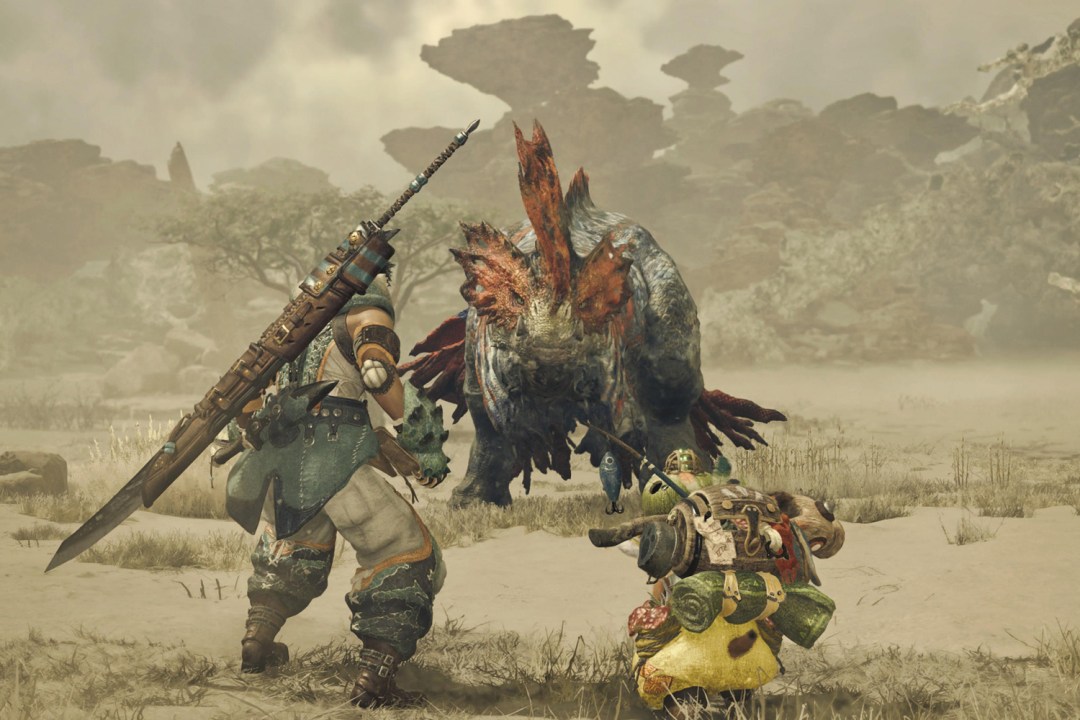Monster Hunter Wilds review: wild things
Capcom's unique monster hunting action RPG series evolves to a new apex

Stuff Verdict
Both the most approachable and most accomplished Monster Hunter yet, Wilds has the systems and the substance to keep you in for the long haul.
Pros
- Exciting hunts and monsters
- Dynamic climate and environments to vary maps
- Immensely replayable and rewarding progression loop
Cons
- Too much focus on story
- Multiplayer still not very seamless
Introduction
Boiled down, Monster Hunter‘s gameplay loop – stalking fearsome creatures for booty to craft better gear with – could be any number of live service loot-grinders. Yet the series, now more than two decades old, remains unique. Imitators like Dauntless and Wild Hearts gone the way of the dodo, while Capcom’s original endures.
Wilds sees Monster Hunter evolving once more, continuing on from 2018’s breakthrough World while also taking ideas from the arcadier 2021 Switch entry Rise. On current gen consoles (or indeed, the souped-up PS5 Pro), the firm’s RE Engine is fully unleashed to make this the biggest entry to date, with dynamic and seamless environments packed with the titular monsters.
There’s plenty of catering to newcomers in the early hours – but can it also please longtime fans? Prepare your potions, forge your blades, and let’s go.
New ecosystems



Hunts aren’t just boss fights in a game map anymore; you’re in a living, breathing ecosystem, of which humans are just one part. These interconnected zones are made up of layers and knotty paths rather than a single open world, and fast-travel hasn’t disappeared, but your base camps are no longer separate levels.
It’s daunting to explore at first, with a vertical and labyrinthian design, but finding specific monsters is easy enough. Mark them on your map and your Seikret – new feathery mounts not a million miles from Final Fantasy’s chocobos – will automatically find the most direct path. That frees you up to use your sling to gather nearby materials, with a generous radius that doesn’t require pinpoint precision. It can also trigger interactive parts of the environment, like loosening rocks or ice from above to come crashing down on an unsuspecting monster.
A new climate system can then drastically alter each biome looks and plays. The starting area initially looks like a typical desert, but later stormy weather rolls in; then you realise it has the capacity for green grasslands and ponds. These conditions determine which monsters show up.
You’ll still of course have your regular fauna to hunt and carve for parts, but these new systems ensure that you’re not just rinsing and repeating the same thing ad nauseum.
Herd it through the grapevine



Still, this is a Monster Hunter game, and it continues to do what it says on the tin very effectively. The initial reveal of new (or indeed returning) monsters remains exciting, as does the immense satisfaction when your attack animations connect and bring a beast down. New mechanics make all the returning weapon types feel fresh, though still second-nature if you’ve already consigned the previous title’s insect glaive to memory.
You can now hold the left trigger and the right stick to aim your weapon – and I’m not just talking about the ranged ones – for targeting specific weak points. Dealing enough damage will cause wounds to appear on a monster, which glow bright red when in this focus mode. Using a cool-looking focus strike then inflicts even more damage, as well as netting you more monster materials.
The monsters have their own tricks, too. Some actually roam the map as a herd now, adding an extra sense of danger when you’re faced with a group. You can usually tell who’s the big cheese, though, and it only takes a couple of tricks to distract or disperse the others.
Better together



Part of the joy of Monster Hunter has long been hunting together, as it makes taking down ginormous dragons and the like more manageable. But teaming up in this seemingly more seamless world isn’t quite as straightforward, despite regularly bumping into fellow hunters in camp.
Actual hunts still need to be instanced, and are limited to 4 players. Besides inviting other hunters to your party, you also need to invite them into what’s referred to as an environment link. Only the host actually makes story progress, and parties are split to experience plot sequences before reconnecting for the hunts.
Sending SOS flares, which eligible players can answer, avoids the faff. If it’s quiet, AI-controlled story companions can join instead, with settings to decide how useful you want them to be.
Even fighting solo you’re never really alone, since you have a cute feline support companion, as well as the Seikret, which you can ride while attacking, using items, or resharpening weapons. They can even hold onto another weapon, which you can swap over to mid-hunt, further opening up your tactics.
Skip to the endgame



Wilds’ direction is significantly more story-focused than before, which I suspect will be quite divisive. The NPCs are more detailed than ever; the player-created protagonist actually speaks during cut-scenes; and there are a lot more cut-scenes to sit through. This makes sense for newcomers, who’ll likely want more motivation than a basic rinse-and-repeat bulletin board full of quests, but there were times when I was thrown into a hunt that I hadn’t actually prepared for.
The story isn’t bad, per se, dealing with what it means to be an interloper in a new land where your role is to responsibly balance the ecosystem rather than plunder it. But it progresses in a linear, scripted manner that undermines a lot of the dynamic new systems.
It’s also on the easy side. I found myself breezing through the plot, always with enough materials to forge new gear (if not a complete armour set), and rarely felt the need to grind for specific gear to get an elemental advantage over a specific monster. The armour looking as stylish as it does is incentive enough, and now they aren’t locked by gender you’re free to mix and match your hunter fashion however you see fit.
For series regulars, the story is essentially a 15-20 hour tutorial before the real game opens up, with high rank hunts that properly incorporate all of Wilds‘ new features. Still, a more accessible and attractive package for a wider audience is a small price to pay when the endgame still offers challenge and reward. Returning monsters (and more to be added post-launch) can have you easily sinking 100 more hours.
Monster Hunter Wilds verdict






It’s another knockout for Capcom: Monster Hunter Wilds evolves this long-running series into its most ambitious iteration yet, with a near-seamless ecosystem of maps, monsters and hunts that remain every bit as thrilling and rewarding.
Series purists may grumble over the more story-led approach, which means it’s not until well into the endgame that you really feel the depth of its dynamic systems. It’s still an entertaining introduction for newcomers, and certainly the most approachable in the series yet. But if it sinks its claws into you well beyond the story, there are few games with loops as compelling and swords as satisfying to swing.
Stuff Says…
Both the most approachable and most accomplished Monster Hunter yet, with the systems and the substance to keep you in for the long haul.
Pros
Exciting hunts and monsters
Dynamic climate and environments to vary maps
Immensely replayable and rewarding progression loop
Cons
Too much focus on story
Multiplayer still not very seamless



